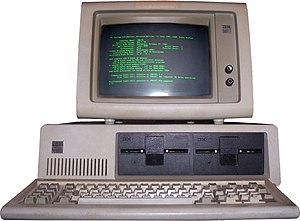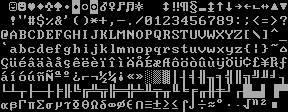IBM Monochrome Display Adapter
 IBM 5151 monitor driven by a Monochrome Display Adapter (MDA) | |
| Release date | 1981 |
|---|---|
| Architecture | Motorola 6845 |
| Cards | |
| Entry-level | IBM MDA, Control Systems Artist 1, Hitachi HD6845SP, UMC UM6845 |
| History | |
| Successor | Hercules Graphics Card, Enhanced Graphics Adapter |
The Monochrome Display Adapter (MDA, also MDA card, Monochrome Display and Printer Adapter, MDPA) is IBM's standard video display card and computer display standard for the PC introduced in 1981. The MDA does not have any pixel-addressable graphics modes, only a single monochrome text mode which can display 80 columns by 25 lines of high resolution text characters or symbols useful for drawing forms.
Hardware design[]

The original IBM MDA was an 8-bit ISA card with a Motorola 6845 display controller, 4 kB of RAM, a DE-9 output port intended for use with an IBM monochrome monitor, and a parallel port for attachment of a printer, avoiding the need to purchase a separate card.[1]
Capabilities[]


The MDA was based on the IBM Datamaster's display system,[2] and was intended to support business and wordprocessing use with its sharp, high-resolution characters. Each character is rendered in a box of 9×14 pixels, of which 7×11 depicts the character itself and the other pixels provide space between character columns and lines. Some characters, such as the lowercase "m", are rendered eight pixels across.[3]
The theoretical total screen display resolution of the MDA is 720×350 pixels, if the dimensions of all character cells are added up, but the MDA cannot address individual pixels to take full advantage of this resolution. Each character cell can be set to one of 256 bitmap characters stored in ROM on the card, and this character set cannot be altered from the built-in hardware code page 437. The only way to simulate "graphics" is through ASCII art.
Code page 437 has 256 characters (0-255), including the standard 95 printable ASCII characters from (32-126), and the 33 ASCII control codes (0-31 and 127) are replaced with printable graphic symbols. It also includes another 128 characters (128-255) like the aforementioned characters for drawing forms. Some of these shapes appear in Unicode as box-drawing characters.
There are several attribute values - bit flags that can be set on each character on the screen. These are invisible, underline, normal, bright (bold), reverse video, and blinking. Reverse video swaps the foreground and background colors, while blinking causes text to flash periodically. Some of these attributes can be combined, so that e.g. bright, underlined text can be rendered.[1]
|
Early versions of the MDA board have hardware capable of outputting red, green and blue TTL signals on the normally unconnected video connector pins, theoretically allowing an 8-color display with a suitable monitor. The registers also allow the monochrome mode to be set on and off. No (widely) published software exists to actually control the feature.[4][1][5]
Use[]
The MDA was released alongside the IBM Color Graphics Adapter, and in fact could be installed alongside the CGA in the same computer. A command included with PC-DOS permitted switching the primary display between the CGA and MDA cards.[6]
Because of the lack of pixel-addressable graphics, MDA owners were unable to play PC games released with graphics support. However, textmode games were released for the PC (including text adventures) and at least one game, IBM's One Hundred And One Monochrome Mazes, requires MDA.[7] Box-drawing characters made the production of rudimentary graphics practical for early PC game titles, including BBS door games or titles such as Castle Adventure.
Another use for the MDA was as a secondary display for debugging. Applications like SoftICE[8] and the Windows debugger[9] permitted the simultaneous use of an MDA and another graphics card, with the MDA displaying a debugger interface while the other card was showing the primary display.
Reception[]
MDA was more popular than the IBM Color Graphics Adapter for business applications. The higher resolution of MDA's text and inclusion of a printer port made it more appealing for the business applications that were the focus of the original PC. However, dissatisfaction with its limitations quickly led to third parties releasing competing hardware.[10]
A well known example was the Hercules Graphics Card. Introduced in 1982, it offered both an MDA-compatible high resolution text mode and a monochrome graphics mode. It could address individual pixels, and displayed a black and white picture of 720×348 pixels. This resolution was superior to the CGA card, yet offered pixel-addressable graphics, so despite lacking color capability, the Hercules adapter's offer of high resolution bitmap graphics combined with MDA-grade text quality made it a popular choice, which was even shipped with many clones.[11]
Specifications[]
Connector[]

| Pin | Function |
|---|---|
| 1 | Ground |
| 2 | Ground |
| 3 | Not Used |
| 4 | Not Used |
| 5 | Not Used |
| 6 | Intensity |
| 7 | Video |
| 8 | Horizontal Sync (+) |
| 9 | Vertical Sync (-) |
Signal[]
| Type | Digital, TTL |
|---|---|
| Resolution | 720h × 350v |
| H-freq | 18.432 kHz |
| V-freq | 50 Hz |
| Colors | 1 |
| Color Intensity | 2-4[13] |
Clone boards[]

Other boards offer MDA compatibility, although with differences on how attributes are displayed or the font used.[1][14]
- 3270 PC
- Amstrad PPC / PC20
- Control Systems Artist 1
- Tamarack Microelectronics TD3088A3
See also[]
- Hercules Graphics Card
- Color Graphics Adapter
- Orchid Graphics Adapter
- Green-screen display
- List of display interfaces
- List of defunct graphics chips and card companies
References[]
- ^ a b c d Elliott, John C. (2005-11-06). "Monochrome Display Adapter: Notes". Archived from the original on 2016-11-23. Retrieved 2016-11-23.
- ^ Bradley, David J. (September 1990). "The Creation of the IBM PC". BYTE. pp. 414–420. Retrieved 2 April 2016.
- ^ IBM MDA manual (PDF).
- ^ Wilton, Richard (1987). Programmer's Guide To PC And PS/2 Video Systems. Microsoft Press. p. 51. ISBN 1-55615-103-9.
- ^ "IBM 5150 - early version". Minuszerodegrees.net. Retrieved 2014-08-30.
- ^ "Dual-Head operation on vintage PCs". www.seasip.info. Retrieved 2020-08-16.
- ^ Manes, Stephen (1984-01-24). "It's Not Easy Being Green". PC Magazine. p. 391. Retrieved 24 October 2013.
- ^ Using SoftICE (PDF). p. 12.
- ^ Inc, InfoWorld Media Group (1991-04-01). InfoWorld. InfoWorld Media Group, Inc.
- ^ Inc, InfoWorld Media Group (1988-09-19). InfoWorld. InfoWorld Media Group, Inc.
- ^ Inc, InfoWorld Media Group (1989-06-26). InfoWorld. InfoWorld Media Group, Inc.
- ^ IBM Personal Computer Hardware Library: Technical Reference (Revised edition, 1983)
- ^ There are four possible combinations of values for the 'Intensity' and 'Video' pins, but not all monitors will display them as four distinct intensity levels.
- ^ "VGA Legacy". vgamuseum.info. Archived from the original on June 29, 2014. Retrieved June 28, 2014.
- Monochrome Display Adapter
- IBM video hardware
- Computer display standards
- Graphics cards
- Computer-related introductions in 1981